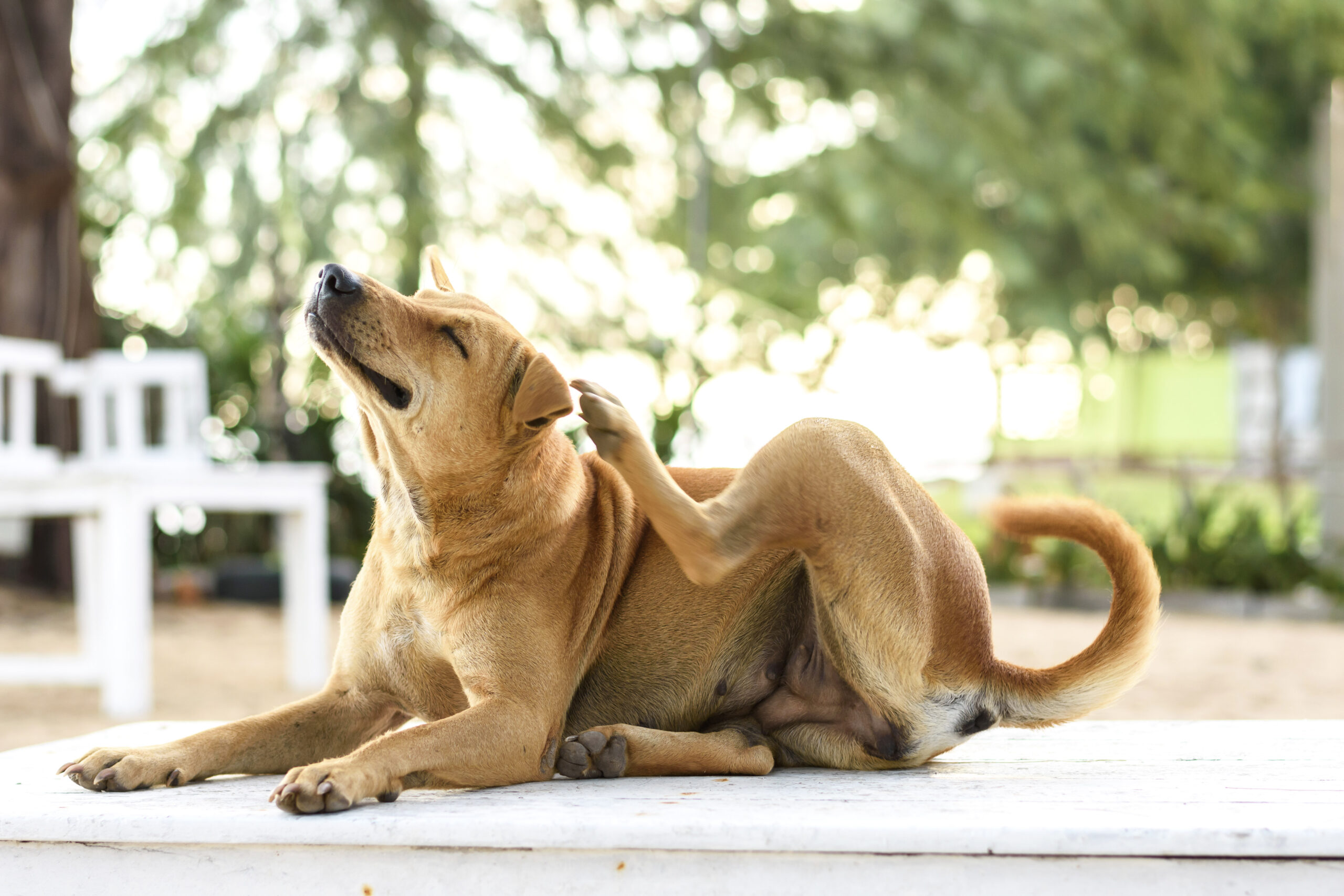What is Flaky Skin?
Just like humans, our canine companions can suffer from flaky skin. Flaky skin in dogs refers to the presence of dry, scaling skin that may result in visible flakes on the coat and hair. While flaky skin can be harmless and temporary, it can also be a sign of underlying diseases or conditions affecting skin health. In this article, we are going to dive into some causes of flaky skin in dogs, and possible ways to treat it.
Signs & Symptoms
Flaky skin in dogs can present with or without pruritus (itchiness). It’s essential to differentiate between pruritic and non-pruritic causes of flaky skin, as it can provide vets with valuable clues as to the underlying cause. It is also important to remember that often, flaky skin is a symptom, rather than a primary diagnosis. Causes of flaky skin can include parasites like demodicosis, scabies, cheyletiella, lice and fleas, allergies, nutritional, bacterial, fungal, autoimmune disorders, some cancers and things like dry skin caused by low humidity or excessive bathing. By evaluating the presence or absence of itchiness, along with other associated symptoms, the veterinarian can better narrow down the underlying cause.
Diagnosis
Discovering the underlying causes for flaky skin may require significant investigation by the veterinarian. This often includes a thorough physical exam, reviewing previous veterinary history, including any history of previous skin problems, and other testing may be needed as well. This might include skin scrapings or impression tests to check for mites, fungal cultures, blood tests to assess organs or hormone levels, and possibly skin biopsies. The diagnostic process aims to rule out various diseases and identify the specific underlying cause of the flaky skin.
Treatment
In the event where skin flakiness doesn’t have a pathological or disease basis, it may be attributed to factors like dry weather. Thankfully some basic measures can be taken to help alleviate the condition if this is the case. This includes ensuring proper hydration and nutrition and providing a complete and balanced diet that includes essential fatty acids. Omega-3 supplements, such as fish oil, are often recommended to help improve skin health in dogs. Check with your veterinarian to get the correct dosage of omega-3 supplement for your pup. Reducing bathing can sometimes help with flaky skin, as excessive shampooing can dry out the hair and remove the natural oils from the coat. There are moisturising shampoos available, and these may provide a milder option for those times when you do need to shampoo your dog. Leave in and moisturising conditioners can also help with dry, flaky skin. In cases where flaky skin is a symptom of an underlying disease, specific treatments for that condition or conditions will be required.
According to PetSure data in 2022, skin disorders had an average claimed cost of $220.00 and a maximum claimed cost of $13,384.
Recovery
Recovery from non-pathological flaky skin is usually straightforward. Adequate hydration, proper nutrition, and environmental modifications, such as ensuring your dog doesn’t spend time too close to the heater, can resolve skin dryness. For cases associated with underlying diseases, the recovery process will depend on the specific condition and the treatment provided. It’s important to follow the veterinarian’s instructions and monitor your dog’s progress during the recovery period.
Prevention
Preventing flaky skin can be as simple as maintaining general health and wellbeing. This means ensuring excellent and balanced nutrition, regular brushing, and bathing with gentle, moisturising products for dogs and avoiding excessive exposure to dry or harsh environments. However, preventing flaky skin associated with underlying diseases can be far more complicated and involves finding and addressing the underlying cause. Consulting with your veterinarian is crucial for developing a preventive plan tailored to your dog’s needs.
FAQ’s
Flaky skin can be caused by
· parasites including demodicosis, scabies, cheyletiella, lice and fleas
· allergies
· nutritional causes
· bacterial and fungal conditions
· autoimmune disorders
· dry skin caused by low humidity or excessive bathing
· certain cancers
Yes, diets that lack certain vitamins, minerals, good quality proteins and fats can all affect the skin and hair. A complete and balanced diet is essential to maintaining a healthy coat. This is why it is very important, especially if feeding exclusively home cooked diets, to address all essential nutrients.
All dogs are different, but as a rule of thumb it is best to only bathe dogs once a month. This allows the natural oils to distribute throughout the skin and hair and avoids drying of the skin. If you need to bathe your dog more frequently than this, use a gentle, moisturising shampoo for dogs and a good quality leave-in conditioner to help keep the skin moisturised.
In cases of dry skin without irritation or itchiness, it may be possible to improve it with some or all of the following things you can do at home:
1. Regular brushing helps distribute natural oils throughout the skin
2. Providing a complete and balanced diet
3. Topical oils such as vitamin E, olive or coconut oil can be applied to patches of dry or rough skin.
4. Omega-3 fatty acid supplements
5. Remove heaters and increase the humidity of the air, especially over winter
6. Oatmeal soaks. Grinding oatmeal into warm water and allowing your pup to soak in it for ten minutes or so can help to calm skin and reduce flakiness.
Consult with your veterinarian before trying natural remedies, especially if your dog’s flaky skin persists or worsens, as there can be many causes for flaky skin in dogs.
Yes, allergies are a common cause of skin irritation and flakiness in dogs. This is often accompanied by pruritus (itchy skin). If your dog is itchy, consult with your veterinarian as itchy skin is very irritating and can affect your dog’s quality of life.
While flaky skin itself is not contagious, there can be underlying causes for flaky skin which may be able to be spread between dogs such as ringworm and parasites, like mange and fleas.
You should reach out to your veterinarian:
· if your dog’s flaky skin persists or worsens
· if your dog appears itchy or in discomfort
· if the flaky skin is spreading to other areas of the body
· if the skin appears red, swollen, has discharge or odours
· if your dog is experiencing other symptoms like changes in appetite, stools, behaviour or activity that may indicate systemic problems
· if your dog has a history of allergic skin disease, other skin or systemic diseases
Diseases affecting the skin are generally covered by comprehensive accidental injury and illness pet insurance policies administered by PetSure (check our brand partners at petsure.com.au/partners), unless related to a pre-existing condition or exclusion. Dry skin not relating to a disease process may not be covered under your policy. Please refer to your policy documents and Product Disclosure Statement (PDS) for more information.*
Preventative and routine items, whether recommended by your veterinarian or not, are generally not covered by PetSure pet insurance policies.
Please refer to your policy documents and Product Disclosure Statement (PDS) for more information
According to PetSure data in 2022, skin disorders had an average claimed cost of $220.00 and a maximum claimed cost of $13,384.
*Reimbursement for these claims would be subject to limits, such as annual benefit limits or sub-limits, benefit percentage, applicable waiting periods and any applicable excess. Cover is subject to the policy terms and conditions. You should consider the relevant Product Disclosure Statement or policy wording available from the relevant provider. Treatment relates to skin conditions and all medically related conditions in that policy period.
Insurance products are issued by The Hollard Insurance Company Pty Ltd ABN 78 090 584 473, AFSL 241436 (Hollard) and/or PetSure (Australia) Pty Ltd ABN 95 075 949 923, AFSL 420183 (PetSure) (from 8 May 2023 only), administered by PetSure and promoted and distributed through their authorised representatives and distribution partners.
Any advice provided is general only and does not take into account your individual objectives, financial situation or needs. Cover is subject to the policy terms and conditions. Please consider the Product Disclosure Statement (PDS) to ensure this product meets your needs before purchasing or choosing to continue with the product. PDS and Target Market Determination available on our partners’ websites. Meet our partners at petsure.com.au/partners.
References
Effect of omega-3 fatty acids on canine atopic dermatitis
Foreyt, W. J., & Bowman, D. D. (2013). Veterinary Parasitology. Wiley-Blackwell.
Moriello, K. A. (2015). Small Animal Dermatology: A Color Atlas and Therapeutic Guide. Elsevier Health Sciences.
Pet insurance can help by covering a portion of the eligible vet bill if the unexpected happens. Because it is difficult to predict the costs of veterinary care, it can help to have measures in place to help prepare for the unexpected. Check out our partner network and explore our policy tools to find a pet insurance policy.
Not all conditions or items are covered by Pet Insurance. Refer to the applicable Product Disclosure Statement for information about coverage and exclusions.



 Fact checked
Fact checked





